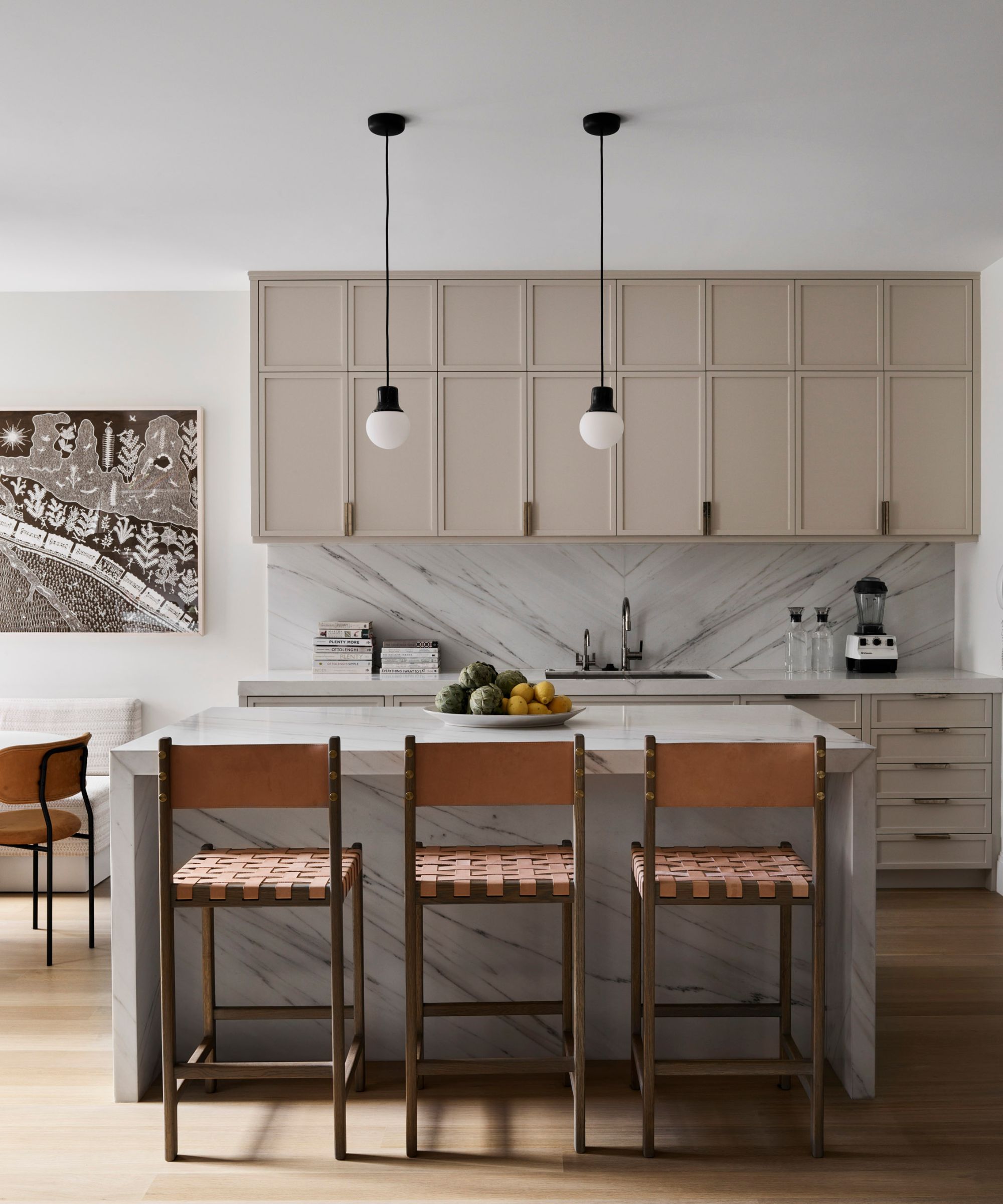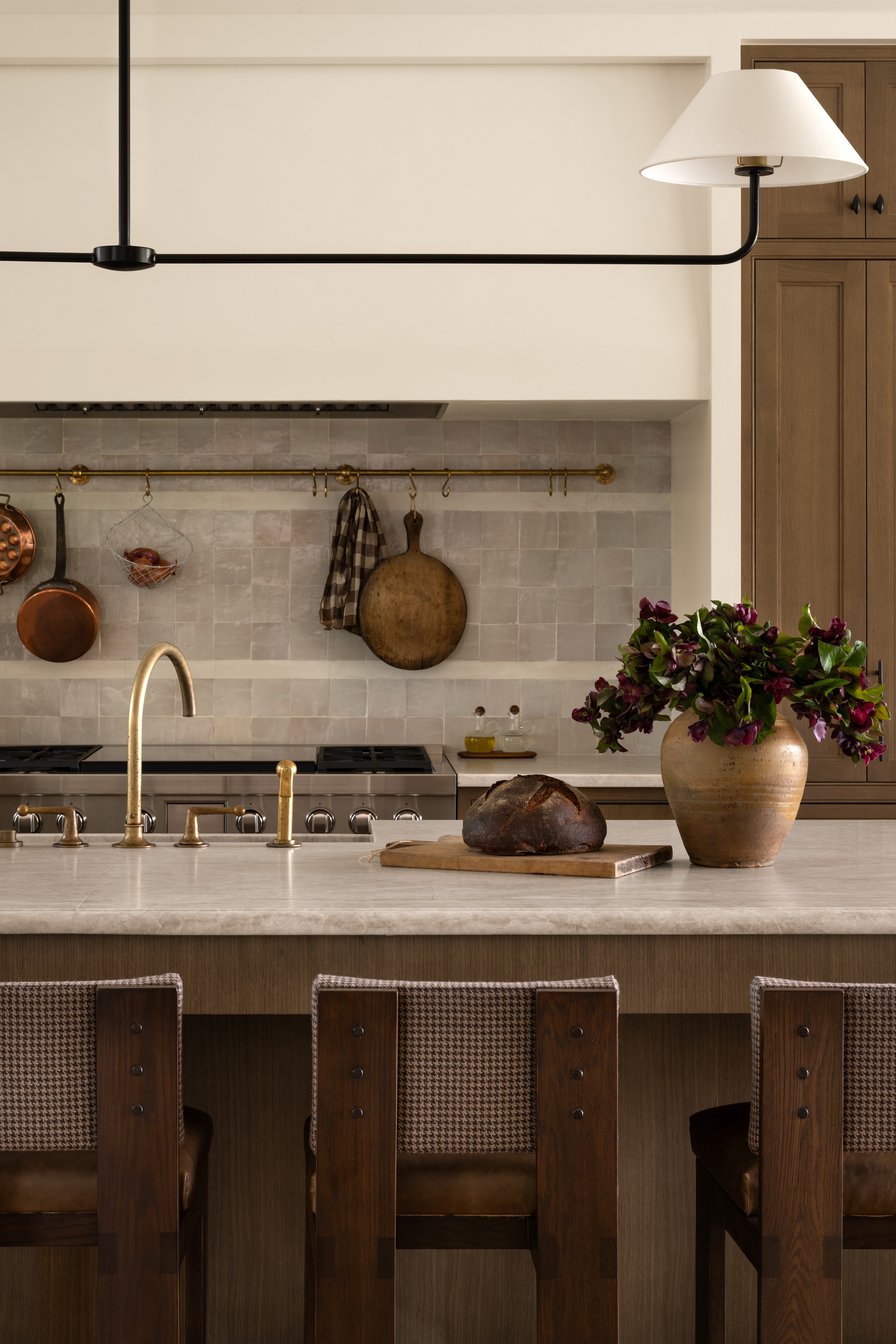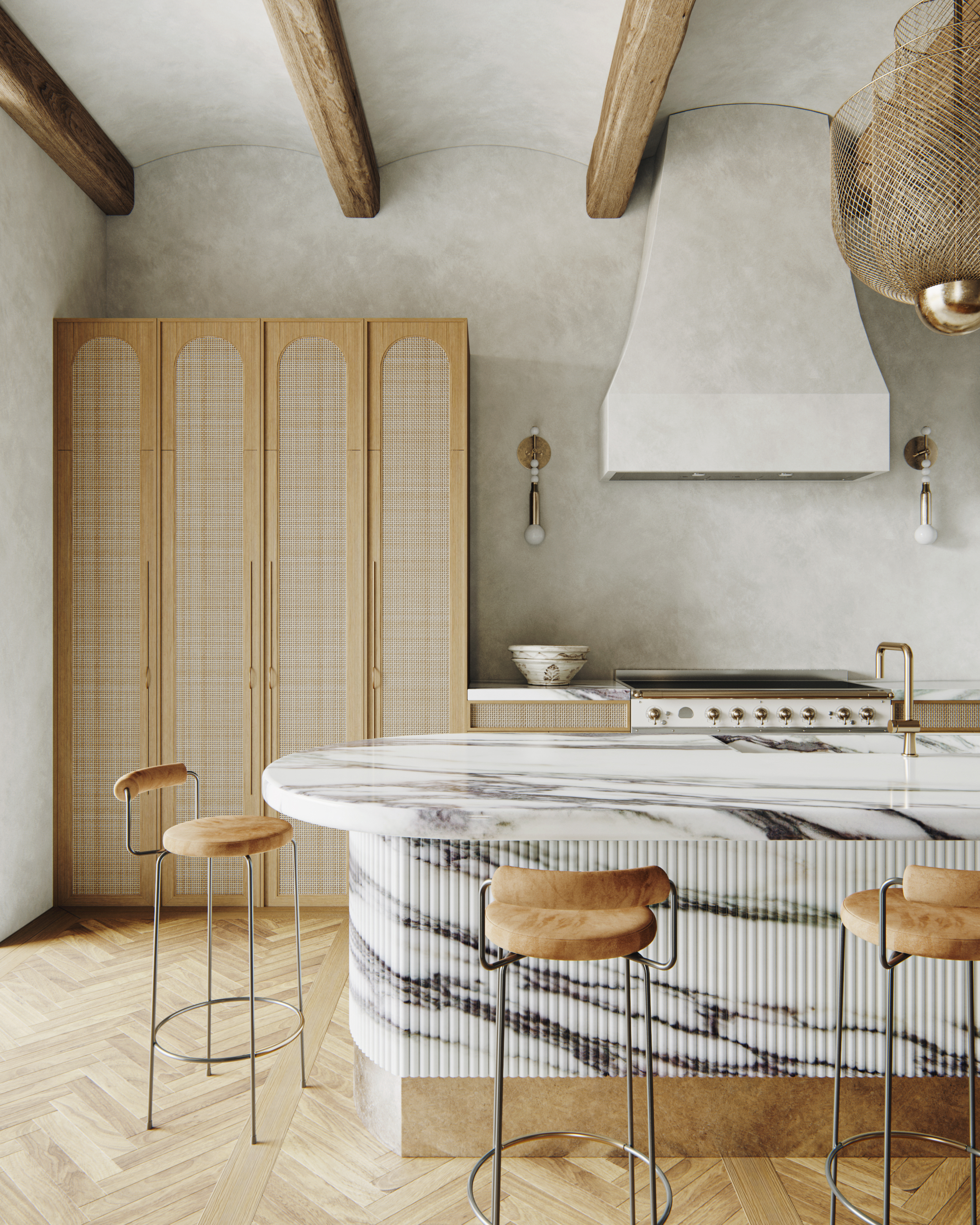Transitional-Style Kitchens — 13 Ideas to Blend the Best of Traditional and Modern Elements in Your Design
Taking the classicism of heritage cabinetry with materials and forms borrowed from contemporary style, this type of kitchen is taking over the design world
Lola Houlton

Right now, everyone wants a transitional-style kitchen — and there's a good chance the same is true for you even if you don't know exactly what one is. Think of it like this — why choose between a more traditional kitchen style and a more contemporary one, when you can cherrypick the best from each.
Transitional-style kitchens have gained immense popularity for their ability to seamlessly blend vintage charm with contemporary sophistication. By combining elements from different eras, these spaces flit effortlessly between styles, creating an aesthetic that is timeless yet modern.
What makes transitional style so appealing is its flexibility; it feels carefree, unbound by strict design rules, and ultimately results in modern kitchens that are balanced, relaxed, fresh, and deeply personal.
When done correctly, bringing old and new together can give a room enduring appeal. Follow these expert tips to achieve the look – and make it feel effortless – in your own space.
1. Incorporate Traditional Features in Updated Styles

“Transitional kitchen style is about using the clean, crisp elements of a traditional style and adding more modern elements that freshen the look and keep it timeless,” says Mariana Ugarte, director and co-founder of the interior design firm Interior Fox. In a transitional kitchen, incorporating traditional features with updated styles can create a balanced space that feels both timeless and current.
Charlie Smallbone, founder of Ledbury Studio, explains, “Transitional kitchen design is the marriage between traditional artisan joinery methods and cutting-edge modern design. Traditional design details, like Georgian-style cockbead, interposed with contemporary engineered details, such as minimal aged brass or wooden frames, give the furniture a contemporary but classic look. One that is timeless yet nonetheless bang up to date.”
Similarly, Shaker-style or paneled cabinetry can nod to tradition but feel updated with subtle hardware and neutral tones. Traditional materials like marble or butcher block countertops can be updated with sleek edges or paired with quartz for a contemporary touch.
The Livingetc newsletters are your inside source for what’s shaping interiors now - and what’s next. Discover trend forecasts, smart style ideas, and curated shopping inspiration that brings design to life. Subscribe today and stay ahead of the curve.
In this kitchen above, the traditional wooden curved legs on a kitchen island are balanced by the modern kitchen island sink, exemplifying the seamless integration of old and new.
However, creating a transitional-style kitchen can be challenging due to the need to incorporate often domineering modern appliances, and with fewer opportunities for decoration and soft furnishings, transitional-style kitchens require careful thought. For example, a classic gas stove can be modernized with sleek stainless steel finishes or bold colors, while a traditional extractor hood takes on clean lines and minimalist shapes enhanced by brass, copper, or decorative strapping. A pot filler in polished chrome, brushed nickel, or even black finishes to marry the classic design with a modern twist.
2. Combine Fitted Cabinets With Freestanding Furniture

In a transitional kitchen, it's improtant to ensure fitted modern kitchen units don’t dominate the room and that there’s space for character to come through elsewhere.
“Use vintage pieces intermingled with functional and beautiful kitchen cupboards,” advises deVOL creative director Helen Parker. “We have been huge fans of an eclectic, freestanding kitchen since the beginnings of deVOL, using pieces of furniture rather than runs of fitted cupboards. It’s a simple way of making your kitchen feel more of an extension of the rest of the house rather than a completely different look.”
If you’re stuck deciding what style of kitchen cabinetry to choose, Shaker-style is a good halfway house between the traditional and contemporary. “Shaker-style kitchens will work—and there are thinner, more modern Shaker-style cabinets which would help to achieve this look too,” says Mariana Ugarte.
3. Go for Marble Countertops

Marble might be at the pricier end of your kitchen countertop options, but when it comes to achieving a transitional look, it could be well worth the investment. This timeless, versatile material seamlessly blends with both modern and traditional styles, making it an excellent choice to bridge the two.
“A defining characteristic of the transitional kitchen is marble worktops, which I regularly incorporate into my designs,” says Ledbury Studio’s Charlie Smallbone. “Over time, the marble develops a personality and patina that reflects its long life in the kitchen, which adds real depth to the overall design,” he says.
Available in a variety of styles – from subtle, soft patterns to classic veining – marble offers a range of colors, from creamy whites to deep grays, so you can find a style complement any kitchen design.
4. Use Hardware to Balance Modern and Traditional Styles

Updating kitchen hardware is a simple, affordable way to strike a balance between modern and traditional design elements in a transitional kitchen. Cabinet pulls, knobs, and handles can effortlessly blend old and new making them an effective tool for creating balance in the space.
Choose shapes and sizes that complement the room’s style. For example, sleek, linear pulls can modernize traditional cabinets, even those with ornate detailing, while more classic designs like cup pulls or rounded knobs can tone down the sharpness of modern cabinets. One of the biggest trends for kitchen cabinet pulls is oversized, streamlined pulls, which add a contemporary touch while blending seamlessly with traditional styles.
Consider the finish and color of the hardware when finding the right option for your transitional kitchen. Brass is a versatile option for a more traditional look, as its warm tone pairs beautifully with most wood finishes. For a bolder, high-contrast look, brass on dark-painted cabinets creates a striking visual effect. Alternatively, polished chrome or matte black finishes can enhance a modern aesthetic while maintaining a timeless appeal in a transitional kitchen design.
5. Use a Mix of Muted Tones

When it comes to color for any transitional style kitchen, muted or neutral tones are key for creating balance.
"Transitional kitchens often benefit from a cohesive and monochromatic color palette. Focus on harmonizing subtle tones," says Alana Marie, founder of Alana Marie Interiors
"A great approach is to choose paint, stone, and wood in similar colors or complementary shades. For example, using variations of the same tone across cabinets, countertops, and flooring creates a unified, elevated look. This technique makes the kitchen feel intentional and unique — more than just a standard design."
Katie Scott says in her designs she often maximizes the use of beautiful, dramatic stone across the entirety of the island to make a statement amongst a neutral color palette.
But while cream kitchens are soothing, using more than one color can also help harmonize the space. “We have never favored sleek, matching, contemporary soulless rooms—we like beautifully painted cupboards, in a mixture of colors,” says Helen Parker.
“Deep, muted colors for cabinets and white marble/quartz countertops, are perfect for achieving this look,” recommends Mariana Ugarte.
6. Use a Mix of Furniture Styles

To create harmony in your transitional-style kitchen, it’s important to strike the right balance with your furniture.
Cecilia Casagrande, interior designer and founder of Casagrande Studio illustrates this balance: "Modern flat-panel cabinets, contemporary counter stools, and a striking geometric light fixture contrast the timeless appeal and old-world craftsmanship of crackle glaze subway tiles and a sculptural metal hood with decorative strapping. This harmonious blend of traditional and modern elements results in a balanced and truly timeless aesthetic."
However, Mariana Ugarte advises avoiding bold furnishings. “Don't go for large statement vintage pieces or statement modern pieces. Instead, try finding vintage coffee table interior design books, and smaller items that tell a story rather than consuming the space.” These subtle, eclectic touches draw the eye in and create intrigue, making the space feel personal and layered.
For instance, in a kitchen like the one designed by Little Greene, a modern, geometric black table adds a clean, contemporary edge and is paired with soft, traditionally rustic chairs, creating a beautiful contrast. This combination of styles ensures the kitchen feels balanced and visually interesting without being cluttered or overly thematic, embodying the essence of transitional design.
7. Create Texture With Tiles

Layering different textures is absolutely key when it comes to marrying old and new styles together. “The sleek, clean-cut lines of a contemporary kitchen can feel cold and impersonal,” says Charlie Smallbone. “By layering in rich texture, you create a kitchen that’s bursting with warmth and character. Think carved natural timber, exquisite veneers with metal inlays, antiqued glass—the list goes on! The result is a truly unique kitchen design that is tailored to the tastes and personality of the person living there.”
Kitchen tile ideas can be a brilliant way of adding texture to a pre-existing kitchen. “If you go for flat kitchen cabinets or move into a newly renovated kitchen that's more modern, you can add off-white zellige tiles to the backsplash,” says Mariana Ugarte. “The texture will help it from not appearing too cold and sterile.”
8. Build Texture Through Layered Lighting

Layered kitchen lighting can also add texture to a room. It makes spaces more adaptable, which is especially important for kitchens, where cooking, entertaining and increasingly working can happen. “A dining table should always be the starting point for ambient lighting—your primary source of light,” says Hanna Walter, product and creative manager, Heathfield & Co. “If you decide to boost ambient light levels with downlights, don’t create a grid across the ceiling. This will create a bland wash of light. Rather, consider where you need the light most.”
Add another layer with task lighting, which could include dimmable lights above your worktops or kitchen island, or in an open plan space that is also a transitional-style dining room. “An island is a chance to add a decorative touch too—to offset the practical lighting that can dominate a kitchen—so choose a pendant (or series of pendants) that will make a statement and draw attention to the centerpiece of your kitchen!
"Top tip: if you’re installing a row of pendants, an odd number of pendants is more pleasing to the eye than an even number.”
As we've seen in transitional-style bedrooms, a key further layer is accent lighting. “This draws attention to specific features in your kitchen,” says Hanna Walter. “For example, if you have niches built into your island unit, make sure you light them so that at night, you can switch off the general lights and dine in their soft glow. Alternatively, you may wish to illuminate favorite artworks or original architectural features.”
9. Keep the Space Balanced and Simple

When designing a transitional kitchen, it's essential to embrace a sense of balance and simplicity. “Keep the kitchen crisp and clean, not having too much clutter on open shelves and the countertop,” recommends Mariana Ugarte. A clutter-free space not only highlights the timeless appeal of a transitional design but also complements its blend of traditional and modern elements.
Incorporating the traits of a minimalist kitchen plays a crucial role in creating a transitional space, ensuring it feels open, inviting, and effortlessly stylish yet also timeless. This blends functionality with style in a way that allows both traditional and modern features to complement each other harmoniously.
10. Incorporate Metal Accents

Metal is a hugely versatile material, and can add real depth and character to a kitchen when used in unexpected ways. “Because of the warm, tactile quality of metals, they have long been used in the kitchen, albeit for smaller elements like brassware,” says Charlie Smallbone.
One of the kitchen trends we're seeing a lot coming through right now is for mixed metals – chromes and golds, darks and warms – which feels like a move away from the dogma of having all one color. The result is a space that encapsulates eclectic style and delights the eye.
11. Incorporate Natural Materials

In a transitional kitchen, using natural materials like wood, stone, and concrete adds a sense of luxury while maintaining a grounded, organic feel.
In the kitchen above, wooden stools and shelves evoke a traditional farmhouse aesthetic, which is beautifully balanced by the sleek, modern wooden cabinetry. Similarly, the rustic stone floor is harmonized by the smooth, minimalist concrete countertop and backsplash, creating a seamless blend of opposing styles through matching materials and complementary tones. This thoughtful combination of textures and finishes results in a space that feels both timeless and contemporary, where natural elements work together to create transitional space.
12. Frame Statement Pieces with Simple Decor

If you do want to include a statement piece, you can maintain the room's balance by making sure the area around it is simple. In the example above, the ornate chandelier is set off beautifully by the minimalist, modern worktop of the kitchen island underneath.
As Studio Morton's Clare Morton puts it: "Take care, particularly when shopping for antiques and vintage pieces not to choose items that are too ornate. If there is a piece that you really want to include that is more ornate—make that a focal point by ensuring that the decor around it is very simple. Keep it simple, paired back and elegant."
13. Always Shop for Quality

The beauty of transitional kitchen design is marrying contrasting objects together—but they should never contrast in terms of quality. "Older pieces are often of a higher quality than modern pieces," says Clare Morton. "Ensure that the modern items chosen are also of a high quality in order to maintain a superior aesthetic throughout the room. Putting cheap looking new pieces next to older, well-made pieces will make them look cheaper still. You don’t need to break the bank, but choose your items carefully."
FAQs
What Are the Best Colors for a Transitional Kitchen?
Neutral color schemes are usually recommended as the perfect color palettes for transitional styles due to their timeless appeal and versatility. Barbara Vargas, product specialist at nobilia North America provides specific color guidance: "White, blue, sand, and sage fit within the three major kitchen design styles — traditional, transitional, and modern — and are suitable for a wide range of homes.
"White and blue often evoke coastal and nautical themes, which are always in style. These colors have been used since ancient times, seen in traditional pottery from the Netherlands and Chinese porcelain, and later in colonial and federal architecture to add character to homes. White is a safe choice for homeowners; it matches everything and makes it easy to decorate a space while blue brings depth to a design. Both colors feel modern while remaining timeless.
"Sand is a go-to choice for homeowners because it creates a light, airy space and makes areas feel larger by reflecting light. Meanwhile, sage adds depth without overwhelming the room. Both colors appear in Art Nouveau movements and as a variation in mid-century modern design (like dark green with walnut)."
Ultimately, whether you opt for white or branch out with some neutral hues to add color to your kitchen, ensure your choices blend seamlessly with traditional and modern elements
What Is a Transitional Style Kitchen Countertop?
"A transitional kitchen countertop often features quartzite, which is durable, heat-resistant, and stain-resistant while offering beautiful veining and color options," explains Alana Marie.
She recommends: "Pair it with high-gloss painted cabinets in a matching tone for a sleek, cohesive look. Using the same stone for both countertops and backsplash creates an elegant, polished style that's sophisticated yet uncomplicated."
The key to creating a beautiful, harmonious transitional kitchen lies in mixing and matching elements in a way that feels seamless and natural.
By blending styles from different periods, incorporating a variety of textures, and carefully selecting materials and finishes, you can achieve a design that balances timeless elegance with modern functionality. This intentional approach can be extended to any transitional space, from transitional-style living rooms to transitional-style dining rooms.
Kate Hollowood is a freelance journalist who writes about a range of topics for Marie Claire UK, from current affairs to features on health, careers and relationships. She is a regular contributor to Livingetc, specializing in reporting on American designers and global interiors trends. Based in London, Kate has also written for titles like the i paper, Refinery29, Cosmopolitan and It’s Nice That.
- Lola HoultonNews writer